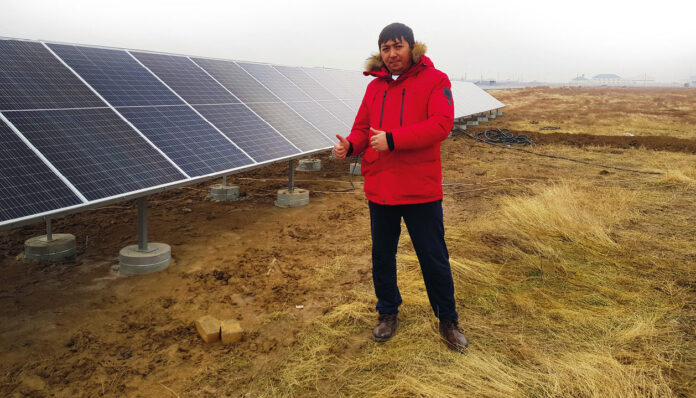Solarway founder Abdulla Ushurov at a 60 kW project for a petrol station in Shymkent, Kazakhstan
Image: Solarway
The Central Asian solar market is on a roll, with Kazakhstan the pioneer and regional leader and Uzbekistan not far behind. Kazakhstan installed 2.7 GW of solar capacity between 2017 and 2021, according to the new REN21’s UNECE Renewable Energy Status Report, and in 2021, added over 1 GW of solar – resulting in it becoming one of the top-30 countries for renewable energy investment.
Uzbekistan’s first utility-scale PV plant, with 100 MW of capacity, was commissioned by the UAE state-owned Masdar in the Navoi region in 2021. In June 2022, the second utility-scale solar plant, of 131 MW, was commissioned by French developer Total Eren in the Samarkand region.
These developments would be impossible without the investment-friendly economic moves that the two countries were undertaking to support the development of renewables, according to Yerlan Ramazanov, regional head of energy for Eurasia at the European Bank for Reconstruction and Development (EBRD). Those include several competitive auctions on solar and wind capacity in both countries.
“In Uzbekistan, the auctions attracted leading renewable energy developers and achieved some of the lowest tariffs internationally on both wind and solar, including $0.0257/kWh on the EBRD-supported 100 MW wind tender last year,” said Ramazanov. “In Kazakhstan, an auction system replaced feed-in tariffs in 2018 and has already tendered approximately 1.3 GW of new renewable capacity. Tariffs have also demonstrated a steady decline, with the weighted-average tariff for solar in 2021 lowered by around 63% and for wind by around 38% compared to the feed-in tariffs.”
The solar expansion in the region is largely pushed by utility-scale projects backed by international financial institutions, most prominently by the EBRD. In Kazakhstan, the bank is the largest investor in renewable energy. By the end of 2021, the bank financed the construction and operation of 12 PV projects with the total value in EBRD financing of €328 million ($318.5 million), according to the bank’s country strategy.
Different paths
The drivers for the development of renewables in both countries are based on security and diversification. Both countries have significant reserves of gas and oil and rely heavily on fossil fuel generation for electricity. Uzbekistan’s electricity consumption is expected to double by 2030 and domestic natural gas production alone will not be able to cover the growing demand, according to the IEA. In Kazakhstan, air pollution from coal power generation, at 70% of the energy mix, is an additional driver.
Despite similar goals, the countries took different paths to attract investment in renewable energy. “Kazakhstan spent about six years on the development of a regulatory framework. Since the adoption of the first law on renewables, it took about six to seven years for the first serious renewable energy projects to be developed,” said Almas Chukin, economist and partner at investment company Visor Kazakhstan. In 2019, Kazakhstan achieved its 2020 target of 3% renewable power generation and raised its 2030 target to 15%.
Meanwhile, developments in Uzbekistan were more ad hoc, according to Chukin. “Uzbekistan needed to swiftly solve energy supply issues and had no time for the development of a regulatory framework,” he said. “Special auctions under the auspices of the government, the IFC, and the ministry of energy were accessible only for ‘giant’ investors.” The advantage of this is speed, he said, but the systematic approach is missing.
In 2019, Uzbekistan declared plans to install 8 GW of renewable energy by 2030 with the aim of achieving a 25% share in electricity generation by 2030. Two years later, the target was raised to 12 GW, including 7 GW solar and 5 GW of wind. Since then, several projects have gone to auction and some were developed through bilateral contracts. After winning the first solar auction tender in 2019, the UAE’s Masdar won a tender for a 457 MW project in the Surkhandarya region and two PV projects totaling 400 MW in the Jizzakh and Samarkand regions.
The latest 131 MW solar project, commissioned by Total Eren in 2022, was initially launched in 2018 during the visit of Uzbek president Shavkat Mirziyoyev to France, with a 25-year PPA agreed. Information about its price of electricity is confidential, the press office of Total Eren told pv magazine.
Small-scale renewables
Beyond utility-scale projects, both countries have seen little progress on distributed, small-scale renewables. But in Kazakhstan, corporate interest for solar is growing, said Abdulla Ushurov, founder of Kazakhstan-based Solarway. “There are no state subsidies or tax breaks for the installation of solar panels. The only incentive for legal entities is the possibility to sell excess energy at a market rate,” he said.
Solarway was founded in 2016 with the adoption of a law on renewable energy feed-in tariffs, which allowed the installation of renewables systems whose excess energy could be sold to the grid. Most of Solarway’s clients come from the corporate sector but each region has its own tariffs.
“There is no single electricity tariff in our country. Each region forms its own tariff, with the highest tariffs in the southern regions. The trend for annual growth of tariffs is up to 4.5%,” said Ushurov. Tariffs based on local currency the tenge have lifted more than 56% since 2016.
Private households in the country also increasingly show interest in renewable energy, said Ushurov, with most installing hybrid inverters with batteries to ensure stable power supply. “Especially in the summer period, renewable energy provides a solution to households during the periods of electricity shortage and rolling blackouts for several hours in the country.” But, for many, solar is still a significant investment because of a lack of state support and an imperfect legislative framework. More financial incentives are needed, added the Solarway founder.
Meanwhile, the government of Uzbekistan is interested in developing distributed, small-scale renewables and the EBRD currently supports the energy ministry with technical cooperation on developing the respective legal and market frameworks, said the EBRD’s Ramazanov.
Challenges of transition
With the increasing share of renewables, the major challenge faced by all stakeholders is securing the integration of intermittent renewable energy. Ramazanov said: “It requires a multidisciplinary approach which includes modernization of grids, introduction of digital solutions, storage and in selected cases introduction of new balancing gas capacity and regional interconnection.” Therefore, the EBRD is financing two investment projects that strengthen the grid in the northwestern part of Uzbekistan, whereas the Kazakhstan Electricity Grid Operating Company (KEGOC) is a long-standing partner and recipient of the bank’s financing.
Visor Kazakhstan’s Chukin says that further deployment of renewables requires powerful flexible generation which is currently lacking in the country. Therefore, in July 2022, two auctions were organized, for 925 MW and 240 MW combined-cycle gas-fired plants which will be built with the aim of balancing renewables in the grid, and two more auctions are planned.
International investors have been eyeing the quickly-developing solar markets in Central Asia. In Kazakhstan, competition with Chinese investors has been tough for the European companies.
“Investors from China practice extremely aggressive pricing to secure infrastructure and grid access in the wind and solar sector. As investors, we do not have access to extremely cheap funds, as is the case in China. As a result, a medium-sized company from Europe, like us, cannot compete with Chinese investors,” said Tobias Schüßler, chief operating officer of German-based developer Goldbeck Solar.
Goldbeck Solar has been active in Kazakhstan since 2017, when first exploring alternative markets during a quiet period in the European solar market. That is when a government-backed pilot solar project, tied to the World Expo in Kazakhstan’s capital city of Astana, emerged, with a project developer from the Czech Republic looking for an EPC and an investor. A 100 MW solar plant on an area of 160 hectares near the town of Karaganda in northern Kazakhstan was commissioned by the end of 2018. In 2019, Goldbeck Solar constructed and commissioned the 50 MW Akadyr solar plant in the Karaganda region under the same green tariff, later adding another 26 MW by auction in 2020.
According to Chukin, Chinese companies have largely won in Central Asia due to a range of competitive advantages. “Prices for Chinese equipment are way lower. For a 100 MW project, costs of equipment from China are in the range of $50 million to $60 million, and from Europe $70 million to $80 million. Another advantage is geography. The cost of large-size cargo transportation accounts for about 15% of a 100 MW project and the difference reaches $20 million to $30 million,” Chukin says. But Chukin says that European companies are strongly represented in terms of technology and knowhow, including key technical solutions for transformers.
Goldbeck’s Schüßler says to foster renewables, several hurdles need to be removed, including bureaucratic obstacles for project-related imports. In addition, local energy suppliers expect daily electricity forecasts and treat PV plants like coal plants, despite solar generation functioning as an intermittent source.
Meanwhile, Goldbeck Solar sees other prospects arising with industry, which is looking for ways to decrease the carbon footprint of energy-intensive products. “We see that the demand for corporate PPAs is increasing. More companies are interested in securing cheap electricity from renewable energy, directly from a PV system into their own factory, whether for hydrogen production or in order to reduce electricity costs. There are first inquiries under way as well as customers and banks that are looking into this area”, Schüßler said. According to him, solar energy is already cheaper than the local energy tariffs. In 2019, the energy tariff was KZT 34/kWh ($0.07), whereas the bid for the second solar plant Akadyr was KZT 17.
By Komila Nabiyeva





